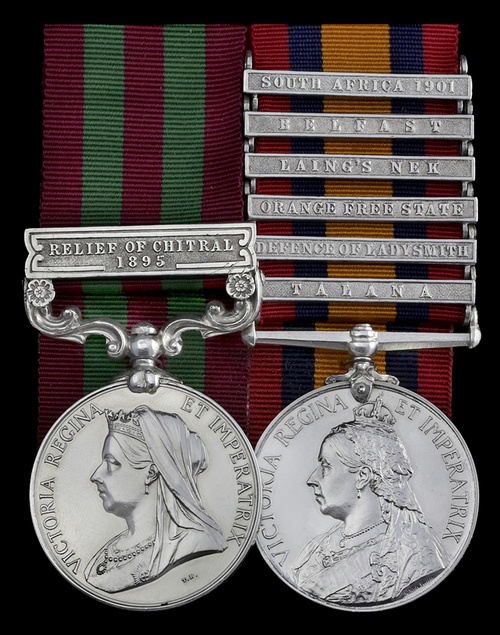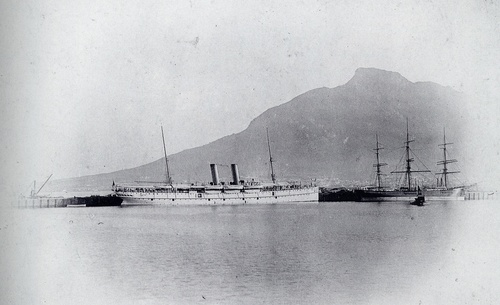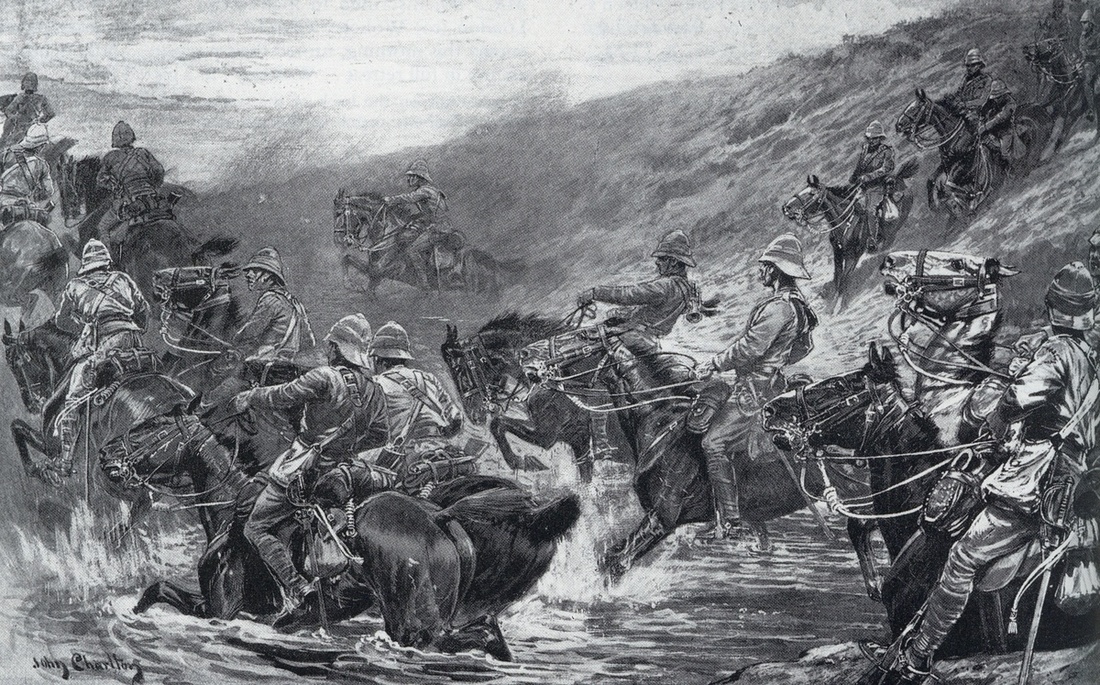Auction: 19002 - Orders, Decorations and Medals
Lot: 107
(x) Pair: Corporal W. Wayman, King's Royal Rifle Corps, a survivor of the loss of the Warren Hastings, who was killed in action with the Mounted Infantry at Gun Hill, Brakenlaagte on 30 October 1901
India General Service 1895-1902, 1 clasp, Relief of Chitral 1895 (5981 Pte. W. Wayman 1st. Bn. K. R. Rifle Corps); Queen's South Africa 1899-1902, 6 clasps, Talana, Defence of Ladysmith, Orange Free State, Laing's Nek, Belfast, South Africa 1901 (5981 Corpl: W. Wayman. K.R.R.C.), dated clasp loose upon riband, extremely fine (2)
William Wayman was born in 1873 and lived with his parents, Charles and Kezia Wayman, at New Road, Offord Cluny, Huntingdon. He enlisted at Winchester in September 1890 and served with the 1st Battalion in India from February 1891. Arriving at Durband on 6 April 1891, Wayman marched for Kohat the next day with the Second Miranzai Expedition, attempting to stave off conflict on the border. The Battalion marched from Kushalgarh to Gumbat and onwards to Kohat, whereupon they halted and rested until the 15 April - establishing a Depot to store kit and leave the riflemen too young for active service, the sick and the weak. Since Wayman was not yet 19 years old, he would have remained in Depot.
On 17 April the first resistance was met at the village of Tsalai. Under cover from No. 3 Mountain Battery, Royal Artillery, two companies of the Rifles rushed the village with the bayonet, losing Colonel Cramer and Major C. C. Egerton severely wounded, plus a Colour-Sergeant and four riflemen wounded. Over the next three days, the Rifles moved forward carefully, brushing aside minor opposition and placing picquets on the covering hills. The enemy accepted terms before the month was out.
On 16 March 1895, the 1st Battalion were prepared for active service with the Chitral Relief Force. Wayman, now of age, together with 18 officers and 800 N.C.O.'s and men left Peshawar for Hoti Mardan as part of the 1st Brigade commanded by Brigadier-General A. A. Kinloch. Attempting a feint towards the Shalkot Pass, 1st Brigade fooled nobody in attempting to distract the enemy's attention for the true point of attack - the Malakand Pass - despite copious efforts to stir up dust and distract attention away from 2nd and 3rd Brigades. The enemy waited in force, unmoved.
Malakand - into action
The enemy's position extended along the crest of the pass, holding the heights on either flank, whilst a series of breastworks built of stone, each commanding the one below, were pushed down the main spurs. On the morning of 3 April 1895, 2nd Brigade supported by 1st Brigade attempted to make a frontal attack, supported on the extreme right by the Guides and 4th Sikhs who began scaling the heights. Such was the steepness of the terrain that it took the Guides five hours to gain the crest, supported by cover from three Mountain Batteries which had pounded the defences for three hours. With the whole of 2nd Brigade engaged, the 1st Battalion, moved forward in support, enabling the 1/60th Rifles and King's Own Scottish Borderer's to catch their breath before fixing bayonets and rushing forward in a final assault. It fell to the 37th Dogra Regiment and Bedfordshire Regiment to pursue the fleeing enemy into the far valley, only halting when they reached Shar on the Swat River. Casualty figures vary, but contemporary sources state that the tribesmen lost around 500 men of the 12,000 engaged. The British lost 11 killed and 51 wounded, Wayman's Battalion accounting for 4 killed and 4 wounded. That night 1st Brigade held the crest of the pass and tended to the wounded.
Relief of Chitral Fort
On 20 April 1895, the British force at Chitral Fort was finally relieved by Colonel Kelly's troops, ending the 47 day siege. The 1st Battalion guarded communications through the Swat Valley occupying the line between Chitral and India for three weeks in extreme heat. Moved to the mountain range of Loram Kotal where they were to be employed in road construction, the men were redirected to Camp Birau within days suffering from sickness, most likely on account of the extreme heat. In September 1895 the Battalion started its return march to India, arriving at Jullundur on 5 October 1895 (Medal & clasp).
Warren Hastings survivor
After a quiet year at Jullundur, the 1st Battalion received orders for South Africa and Mauritius. Departing on 30 November 1896, the Battalion arrived at Deolali on 5 December and boarded the steel turnscrew troopship Warren Hastings, rigged as a two-masted schooner, on 12 December. After coaling in the Seychelles, the ship docked at Cape Town on 28 December, disembarking 'B', 'D', 'E' and 'F' Companies for garrison duty at Wynburg. Remaining aboard for Mauritius were the Headquarters, 'A', 'C', 'G' and 'H' Companies, including Wayman and 10 ladies, women and children of the Regiment, in total 1246 passengers and crew including four fresh Companies from the 2nd Battalion, York and Lancaster Regiment.
The passage was tranquil until the morning of 13 January; the barometer fell and the wind shifted to the south. Observations were difficult and it began to rain, but still her Captain - Commander Holland - expected to make Mauritius. At 02.20am the next day, steaming at 12 knots on a filthy night, the Warren Hastings ran aground off the Island of Reunion, all aboard being awakened by the sudden impact.
Lieutenant-Colonel Forestier-Walker, Officer in Command of Troops, hurried to the bridge and reported to Commander Holland, who ordered that all men should fall in below on the main and troop decks, leaving only the sentries above decks. Given the heavy bumping, grating and flooding which clearly indicated the ship was aground and in danger of sinking, the discipline of the men was remarkable as the ship gradually began to list to starboard. By 04.20am it was evident that the evacuation of the women, children and the sick could not be delayed until daylight. They were passed forward, the men at the bow standing quietly aside as they were carried or lowered onto the wet, slick rocks below.
As the list worsened the seas started to break over the upper deck. With water up to their knees, the men on the starboard side were forced to cling to the rails for support, later ordered to discard boots and rifles and move if possible to the port rail. At 4.35am the electric lights failed and the evacuation continued by feel, with the men climbing down on lines and rope ladders amidst numerous acts of heroism and bravery. An hour later, all men had made it off the ship which had finally settled securely upon rocks and an attempt at salvage was begun. Amid rising seas only the very top items in the holds could be reached -all else was lost. At roll call in St. Phillippe all troops were accounted as present, only two natives being reported as missing and likely drowned. Thankful for deliverance, the survivors marched for a number of days to Pointe des Galets where they embarked upon the S.S. Lalpoora for their original destination, Port Lewis, Mauritius.
Such was the scale of loss of weaponry, clothing and foodstuffs that the Rifle's Adjutant, Captain R. M. Stuart-Wortley later wrote:
'I doubt if a more ragamuffin looking set ever marched as part of the British forces. Many had no coats, all sorts of hats were to be seen, and one or two had even no trousers.'
South Africa - Journey's end
On 5 March 1899, Headquarter's Wing, including Wayman, embarked at Port Louis aboard the R.I.M.S. Clive for Natal. Arriving at Durban on 21 March they entrained for Pietermaritzburg with 5 officers and 41 N.C.O's and men. Selected for the Mounted Infantry, he moved to camp in Dundee on 11 October and served during the Battle of Talana where he likely formed part of two sections of the Mounted Infantry which acted as escort to two artillery batteries shelling the Boers on Talana Hill. The remaining 22 men of the Mounted Infantry section acted as escort to a Maxim-gun team and men of the 18th Hussars and were later captured.
Having survived a raft of pitched battles and vicious skirmishes against an enemy increasingly using guerrilla tactics, Wayman's luck deserted him on the morning of 30 October 1901. Amidst heavy rains, thick mist and flooded spruits, the Boers attacked the rear-guard of a British column which had started off from Cypherfontein Camp at 4.30am. The column was struggling to progress at any great pace through the clammy, rain sodden mud.
At around 11.00am, Sergeant Ashfield's section from No. 1 Company, King's Royal Rifle Corps (Mounted Infantry) - which included Wayman - was detached as an escort to two guns of the 84th Battery, Royal Field Artillery, with orders to cover any potential withdrawal from high ground south-east of the Camp, later known as 'Gun Hill'. From here the two 15-pounders, deployed 20 yards apart, were to cover the convoy's laager 2500yds away at Brakenlaagte, whilst defended by 20 N.C.O.'s and men, including Wayman. Minutes later, they were joined by a further 160 men of the Scottish Horse and Yorkshire Mounted Infantry forming a scanty line around the position.
For General Botha, the sight of such thinly spread British forces was too tempting to ignore. Having concealed at least 900 Boer horseman behind a further ridge, he ordered a charge, the weight of the attack being firmly upon Gun Hill. Galloping in one wide line, Botha's mounted troops overran isolated pockets of rearguard troops. These included a Company of The Buffs, slashing right through them, killing and wounding 19 men - mostly before they had time to fire. Reaching the dead ground before Gun Hill, the Boers dismounted and attacked on foot. Despite the efforts of the artillery, the flood of Boers rolled on, the small party of Mounted Infantry forced to settle into three small depressions at 12.30pm, determined to hold their position at all costs.
On Gun Hill some of the fiercest fighting of the war ensued with a confused fire-fight at close range and the British hopelessly outnumbered. The artillery serving the 15-pounders lost heavily, firing only three rounds - the last two of case shot - before they were shot down.
In Sergeant Ashfield's detachment of twenty, 17 were casualties, including Wayman, who was killed in the action. The three unwounded were horse holders. Of the 40 Yorkshire Light Infantry positioned upon the hill, 27 became casualties, the Boers successfully capturing the guns and taking the summit within 25 minutes.
Originally buried in the field at Nooitgedacht, his body was later exhumed and reburied in the Primrose Garden Cemetery, Germiston, South Africa. His name also commemorated on the Huntingdonshire Memorial; sold with copied service papers and extensive private research.
Subject to 5% tax on Hammer Price in addition to 20% VAT on Buyer’s Premium.
Sold for
£1,000
Starting price
£320









